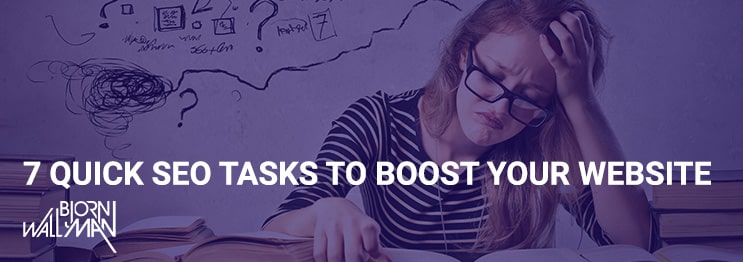7 Quick Tasks and Easy Fixes To Help You Boost Your Site’s Ranking
SEO professionals are hailed as the unsung champions of the digital realm, endowed with the formidable ability to bolster website traffic, elevate search engine rankings, and amplify the all-important return on investment for the organizations they diligently serve. However, their journey is often fraught with impediments and limitations. Picture this: a dedicated SEO expert confronted with a website that resolutely refuses to embrace responsiveness or one that’s still stuck in the bygone era of the late ’90s, desperately begging for a modern makeover. What if the server, that vital cog in the online machinery, persistently falters like a flickering beacon in the night?
In these trying moments, it becomes evident that SEO virtuosos cannot simply wave a magic wand and resolve every quandary that plagues a website. The constraints aren’t rooted in a lack of expertise or acumen; far from it. More often than not, the path to rectify these issues is fraught with hurdles, requiring the elusive nod of higher-ups, the collaborative synergy of third-party vendors, and the harmonious alignment of developers.
So, in the face of these formidable challenges and roadblocks, the question arises: How do SEO professionals muster the fortitude to press onward in their mission? The answer, it turns out, lies in their ability to wield influence and enact impactful change, all without the need for external input or the approval of other stakeholders. Are you eager to discover the secrets of their ingenuity? Read on, for we shall unravel the tools and strategies that empower SEO experts to effect significant transformations on a website, all with a stroke of their digital prowess.
1. Alter Your Title Tags
If the title tags for your site aren’t optimized, your site will not perform well in the SERPs. The problem is that website designers or developers don’t consider these SEO ramifications and will typically place stock text in their title tags. As the SEO, you will have to fix this. Not sure where to begin? Here are some guidelines that will help you optimize your title tags:
- Your title tag should be between 50 and 60 characters long
- Place a longtail keyword in the title to optimize the title tag
- Your target longtail keyword should be in, or close to, the beginning of the title
In addition, consider implementing the following steps for better title tag optimization:
- Use a unique long tail keyword for each page on your site
- Change the title tag so that it includes the assigned keyword
- If the site is fairly large, place your focus on the most important pages, like top traffic pages, first.
2. Optimize H1s
The section of HTML code that pinpoints a huge heading in your content is called the H1 tag. It is one of the most common SEO elements and has been in use for years. But, there are some problems that are associated with H1s, they include:
- Multiple H1s
- Short H1s
- Duplicate H1s
- Very long H1s
When it comes to analyzing a site’s H1 tags, Screaming Frog is one of the most useful tools available. It can help you identify:
- Pages without an H1
- Pages with duplicate H1s
- Pages with H1s that are over 70 characters
- Pages with multiple H1s
3. Add Extra Content
Google’s affection for content is an open secret in the world of digital marketing, and the equation is elegantly simple: more content equates to higher-ranking pages. This correlation between content length and top-ranked pages has been substantiated by serpIQ’s in-depth study, which unveiled a robust connection between abundant content and the pinnacle of search results. To harness the immense potential latent in this correlation, it’s imperative to adorn your website with content that is not only voluminous but also exudes excellence.
The crux of the matter lies in providing your audience with high-caliber content that not only meets but surpasses their expectations, effectively solving their problems and catering to their pressing needs. In this endeavor, you’re not just feeding the content-hungry algorithms of search engines; you’re actively engaging, educating, and delighting your visitors, fostering a strong and lasting connection with your audience. So, in the grand tapestry of SEO, remember that the more you enrich your website with substantial, high-quality content, the more Google and your audience alike will be inclined to elevate your pages to the zenith of search engine rankings.
4. Add Alt Tags to Your Pictures
The alt tag of an image serves as its metadata, providing a textual description that aids in conveying the image’s content and purpose. Occasionally, your Content Management System (CMS) may automatically assign alt tags to your images, yet these defaults often lack the finesse of optimization. To ensure that your images are well-equipped for SEO and accessibility, you can take matters into your own hands. Here’s how to optimize these tags manually:
1. Audit with Screaming Frog: Initiate the optimization process by employing a tool like Screaming Frog. It will scan your website, revealing the current state of your alt tags. This invaluable insight allows you to gauge the effectiveness of your image descriptions.
2. Review and Modify: Armed with the information from the audit, dive into your image source code or attributes. Locate the alt tag associated with each image you wish to optimize.
3. Enhance Alt Tags: Craft alt tags that are descriptive, concise, and relevant to the image’s content and context on the webpage. Incorporate target keywords if appropriate, but avoid keyword stuffing, as the primary goal is to provide a useful and accurate description.
4. Accessibility Considerations: Keep in mind that alt tags play a crucial role in web accessibility, enabling individuals with visual impairments to understand the content of your images. Ensure your alt tags are not only SEO-friendly but also inclusive and descriptive for these users.
5. Implement Changes: Save your changes in the image source code or attributes to replace the existing alt tags with your optimized descriptions.
By taking these steps, you’ll not only boost the SEO potential of your images but also enhance the accessibility and user-friendliness of your website, contributing to a more informative and inclusive online experience.
5. Add Internal Links
If you want search engines to be able to easily access your site, it’s important that your website is crawlable. One of the best ways to go this is by building internal links.
Internal links lead from one page of content on your site to another. They are fairly easy to implement, all you have to do is go to the existing content on your site and add text links that will take you to another page. But, before you begin, there are some things that you should keep in mind:
- Add an average of 3 internal links per page
- Don’t link to the homepage or the “about” page
- Link to content rich pages
6. Improve Readability of Content
In the contemporary landscape of SEO, the paramount focus is on usability. Ensuring that your content is not just informative but also highly user-friendly is key to success. This involves making every possible effort to present your content in a manner that’s easy to view, read, and digest. To achieve this, consider implementing the following practices:
1. Structured Content: Break down your content into well-organized sections with the use of headings, subheadings, and sub-subheadings. This hierarchical structure not only aids in readability but also enhances the comprehension of your material.
2. Bullet Points and Lists: Incorporate bullet points and numbered lists to highlight key points, steps, or features. Lists are a powerful tool for making information concise and scannable, which is highly preferred by online readers.
3. Concise Paragraphs: Keep your paragraphs short and focused. Long blocks of text can be overwhelming and deter readers. Aim for clarity and concise communication to maintain reader engagement.
4. Visual Elements: Complement your text with visual aids, such as images, infographics, and videos, to convey complex ideas and information more effectively. Visual content enhances user engagement and retention.
5. Mobile Optimization: Ensure that your content is responsive and displays well on various devices, including mobile phones and tablets. Mobile-friendly content is not only user-friendly but also favored by search engines in their rankings.
6. Page Load Speed: Optimize your website for quick page load times. A fast-loading site enhances the user experience and is a ranking factor in search algorithms.
7. User Experience (UX) Design: Consider the overall design and layout of your website. Intuitive navigation, clear calls to action, and an appealing visual design all contribute to a positive user experience.
When your content is structured, concise, and enhanced with visual elements, it becomes more readable, engaging, and, consequently, more attractive to both human readers and search engines. In this era of SEO, the ultimate goal is to create a harmonious experience where information is not just accessible but also digestible, ensuring that your website rises in the rankings while keeping your audience engaged and satisfied.
7. Alter and Optimize Your Meta Descriptions
A meta description, succinctly encapsulating your page’s essence in approximately 160 characters, serves as a window into your content. While it doesn’t directly influence search rankings, its impact on your search presence is unmistakable, albeit through indirect channels. This is attributed to the fact that meta descriptions are prominently featured in the Search Engine Results Pages (SERPs), where they wield the power to sway a user’s decision to click on a particular page and the speed at which they make that choice.
For optimal results, here are a few critical considerations when crafting your meta descriptions:
1. Length Matters: Stick to the prescribed character limit to ensure that your meta description displays in its entirety. A concise and well-structured description is more likely to capture a user’s attention.
2. Relevance Is Key: Make sure that your meta description accurately reflects the content of the page. Misleading descriptions can lead to a poor user experience and higher bounce rates.
3. Engage and Appeal: Craft meta descriptions that are not just informative but also compelling and engaging. Use persuasive language that entices users to click and explore your page further.
In the realm of SEO, meta descriptions may not directly determine your ranking, but they wield influence over your click-through rates, user engagement, and ultimately, your website’s performance. By adhering to these guidelines, you ensure that your meta descriptions are an effective tool for enhancing your presence in search results and drawing users to your valuable content.







